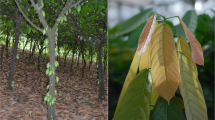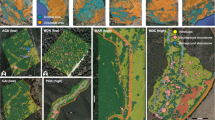Abstract
Adaptive plasticity is expected to be important when the grain of environmental variation is encompassed in offspring dispersal distance. We investigated patterns of local adaptation, selection and plasticity in an association of plant morphology with fine-scale habitat shifts from oak canopy understory to adjacent grassland habitat in Claytonia perfoliata. Populations from beneath the canopy of oak trees were >90 % broad leaved and large seeded, while plants from adjacent grassland habitat were >90 % linear-leaved and small seeded. In a 2-year study, we used reciprocal transplants and phenotypic selection analysis to investigate local adaptation, selection, plasticity and maternal effects in this trait-environment association. Transgenerational effects were studied by planting offspring of inbred maternal families grown in both environments across the same environments in the second year. Reciprocal transplants revealed local adaptation to habitat type: broad-leaved forms had higher fitness in oak understory and linear-leaved plants had higher fitness in open grassland habitat. Phenotypic selection analyses indicated selection for narrower leaves and lower SLA in open habitat, and selection for broad leaves and intermediate values of SLA in understory. Both plant morphs exhibited plastic responses in traits in the same direction as selection on traits (narrower leaves and lower SLA in open habitat) suggesting that plasticity is adaptive. We detected an adaptive transgenerational effect in which maternal environment influenced offspring fitness; offspring of grassland-reared plants had higher fitness than understory-reared plants when grown in grassland. We did not detect costs of plasticity, but did find a positive association between leaf shape plasticity and fitness in linear-leaved plants in grassland habitat. Together, these findings indicate that fixed differences in trait values corresponding to selection across habitat contribute to local adaptation, but that plasticity and maternal environmental effects may be favored through promotion of survival across heterogeneous environments.




Similar content being viewed by others
References
Abramoff MD, Magelhaes PJ, Ram SJ (2004) Image processing with ImageJ. Biophotonics Int 11:36–42
Ackerly D, Knight C, Weiss S, Barton K, Starmer K (2002) Leaf size, specific leaf area and microhabitat distribution of chaparral woody plants: contrasting patterns in species level and community level analyses. Oecologia 130(3):449–457
Agrawal AA (1998) Induced responses to herbivory and increased plant performance. Science 279(5354):1201–1202
Agrawal AA, Laforsch C, Tollrian R (1999) Transgenerational induction of defences in animals and plants. Nature 401(6748):60–63
Auld JR, Agrawal AA, Relyea RA (2010) Re-evaluating the costs and limits of adaptive phenotypic plasticity. Proc R Soc B Biol Sci 277(1681):503–511
Baldwin IT (1999) Inducible nicotine production in Native Nicotiana as an example of adaptive phenotypic plasticity. J Chem Ecol 25(1):3–30
Baythavong BS (2011) Linking the spatial scale of environmental variation and the evolution of phenotypic plasticity: selection favors adaptive plasticity in fine-grained environments. Am Nat 178(1):75–87
Becker C, Weigel D (2012) Epigenetic variation: origin and transgenerational inheritance. Curr Opin Plant Biol 15(5):562–567
Bell DL, Galloway LF (2008) Population differentiation for plasticity to light in an annual herb: adaptation and cost. Am J Bot 95(1):59–65
Benard MF (2004) Predator-induced phenotypic plasticity in organisms with complex life histories. Annu Rev Ecol Evol Syst 35:651–673
Boege K (2010) Induced responses to competition and herbivory: natural selection on multi-trait phenotypic plasticity. Ecology 91(9):2628–2637
Bradshaw AD (1965) Evolutionary significance of phenotypic plasticity in plants. Adv Genet 13:115–155
Chapin SFI, Bloom AJ, Field CB, Waring RH (1987) Plant responses to multiple environmental factors. Bioscience 37(1):49–57
DeWitt TJ, Sih A, Wilson DS (1998) Costs and limits of phenotypic plasticity. Trends Ecol Evol 13(2):77–81
Donohue K, Messiqua D, Pyle EH, Heschel MS, Schmitt J (2000) Evidence of adaptive divergence in plasticity: density and site dependent selection on shade avoidance responses in Impatiens capensis. Evolution 54(6):1956–1968
Dyer AR, Brown CS, Espeland EK, McKay JK, Meimberg H, Rice KJ (2010) SYNTHESIS: the role of adaptive trans-generational plasticity in biological invasions of plants. Evol Appl 3(2):179–192
Espeland EK, Rice KJ (2012) Within- and trans-generational plasticity affects the opportunity for selection in barbed goatgrass (Aegilops triuncialis). Am J Bot 99(12):2058–2062
Evans JR, Poorter H (2001) Photosynthetic acclimation of plants to growth irradiance: the relative importance of specific leaf area and nitrogen partitioning in maximizing carbon gain. Plant, Cell Environ 24(8):755–767
Fonseca CR, Overton JM, Collins B, Westoby M (2000) Shifts in trait-combinations along rainfall and phosphorus gradients. J Ecol 88(6):964–977
Fournier D, Skaug H, Ancheta J, Ianelli J, Magnusson A, Maunder M, Nielsen A, Sibert J (2012) AD Model Builder: using automatic differentiation for statistical inference of highly parameterized complex nonlinear models. Optim Methods Softw 27:233–249
Galloway LF, Etterson JR (2007) Transgenerational plasticity is adaptive in the wild. Science 318(5853):1134–1136
Ghalambor CK, McKay JK, Carroll SP, Reznick DN (2007) Adaptive versus non-adaptive phenotypic plasticity and the potential for contemporary adaptation in new environments. Funct Ecol 21(3):394–407
Gommers CMM, Visser EJW, Onge KRS, Voesenek LACJ, Pierik R (2013) Shade tolerance: when growing tall is not an option. Trends Plant Sci 18(2):65–71
Harper JL (1977) Population biology of plants. Academic Press, London
Herman JJ, Sultan SE, Horgan-Kobelski T, Riggs C (2012) Adaptive transgenerational plasticity in an annual plant: grandparental and parental drought stress enhance performance of seedlings in dry soil. Integr Comp Biol 52(1):77–88
Holeski LM, Jander G, Agrawal AA (2012) Transgenerational defense induction and epigenetic inheritance in plants. Trends Ecol Evol 27(11):618–626
Jepson WL (1925) Manual of the flowering plants of California. University of California Press, Berkeley
Karban R (2011) The ecology and evolution of induced resistance against herbivores. Funct Ecol 25(2):339–347
Kassen R (2002) The experimental evolution of specialists, generalists, and the maintenance of diversity. J Evol Biol 15(2):173–190
Kim E, Donohue K (2011) Population differentiation and plasticity in vegetative ontogeny: effects on life-history expression in Erysimum capitatum (Brassicaceae). Am J Bot 98(11):1752–1761
Kingsolver JG (1995) Fitness consequences of seasonal polyphenism in western white butterflies. Evolution 49(5):942–954
Kurepin LV, Farrow S, Walton LJ, Emery RJN, Pharis RP, Chinnappa CC (2012) Phenotypic plasticity of sun and shade ecotypes of Stellaria longipes in response to light quality signaling: Cytokinins. Environ Exp Bot 84:25–32
Lande R, Arnold SJ (1983) The measurement of selection on correlated characters. Evolution 37(6):1210–1226
Langerhans RB, Chapman LJ, Dewitt TJ (2007) Complex phenotype–environment associations revealed in an East African cyprinid. J Evol Biol 20(3):1171–1181
Leishman MR, Westoby M (1994) The role of large seed size in shaded conditions—experimental evidence. Funct Ecol 8:205–214
Levins R (1968) Evolution in changing environments. Princeton University Press, Princeton, NJ
McIntyre PJ (2012) Cytogeography and genome size variation in the Claytonia perfoliata (Portulacaceae) polyploid complex. Ann Bot 110(6):1195–1203
Michel M (2011) Spatial dependence of phenotype-environment associations for tadpoles in natural ponds. Evol Ecol 25(4):915–932
Miller JM (1978) Phenotypic variation, distribution and relationships of diploid and tetraploid populations of the Claytonia perfoliata complex (Portulacaceae). Syst Bot 3:322–341
Miller JM, Chambers KL (2006) Systematics of Claytonia (Portulaceae). Syst Bot Monogr 78:1–236
Miller JM, Kenton LC, Fellows CE (1984) Cytogeographic patterns and relationships in the Claytonia sibirica complex (Portulacaceae). Syst Bot 9(3):266–271
Pigliucci M, Pollard H, Cruzan MB (2003) Comparative studies of evolutionary responses to light environments in arabidopsis. Am Nat 161(1):68–82
R Development Core Team (2013) R: a language and environment for statistical computing. R Foundation for Statistical Computing, Vienna
Rausch JH (2008) The evolution of selfing, inbreeding depression, and polyploidy in the Claytiona perfoliata complex (Portulacaceae). Washington State University, Pullman
Rodríguez RL (2012) Grain of environment explains variation in the strength of genotype × environment interaction. J Evol Biol 25(9):1897–1901
SAS Institute I (2013) JMP v. 10.0. Cary, NC
Scheiner SM, Berrigan D (1998) The genetics of phenotypic plasticity. VIII. The cost of plasticity in Daphnia pulex. Evolution 52(2):368–378
Schlichting CD (1986) The evolution of phenotypic plasticity in plants. Annu Rev Ecol Syst 17(ArticleType: research-article/Full publication date: 1986/Copyright © 1986 Annual Reviews): 667–693
Schmitt J, McCormac AC, Smith H (1995) A test of the adaptive plasticity hypothesis using transgenic and mutant plants disabled in phytochrome-mediated elongation responses to neighbors. Am Nat 146(6):937–953
Skaug H, Fournier D, Nielsen A, Magnusson A, Bolker B (2012) Generalized linear mixed models using AD model builder. R package version 0.7.4
Stanton ML, Thiede DA (2005) Statistical convenience vs biological insight: consequences of data transformation for the analysis of fitness variation in heterogeneous environments. New Phytol 166(1):319–338
Sultan SE, Bazzaz FA (1993) Phenotypic plasticity in Polygonum persicaria. I. Diversity and uniformity in genotypic norms of reaction to light. Evolution 47(4):1009–1031
Sultan SE, Spencer HG (2002) Metapopulation structure favors plasticity over local adaptation. Am Nat 160(2):271–283
Swanson JR (1964) Claytonia (Montia) perfoliata: a genecological and evolutionary study [PhD]: University of California at Berkeley
Valladares F, Gianoli E, Gómez JM (2007) Ecological limits to plant phenotypic plasticity. New Phytol 176(4):749–763
van Kleunen M, Fischer M (2005) Constraints on the evolution of adaptive phenotypic plasticity in plants. New Phytol 166:49–60
Via S, Lande R (1985) Genotype-environment interaction and the evolution of phenotypic plasticity. Evolution 39(3):505–522
Via S, Gomulkiewicz R, De Jong G, Scheiner SM, Schlichting CD, Van Tienderen PH (1995) Adaptive phenotypic plasticity: consensus and controversy. Trends Ecol Evol 10(5):212–217
Weijschedé J, Martínková J, De Kroon H, Huber H (2006) Shade avoidance in Trifolium repens: costs and benefits of plasticity in petiole length and leaf size. New Phytol 172(4):655–666
Wright SJ, Kitajima K, Kraft NJB, Reich PB, Wright IJ, Bunker DE, Condit R, Dalling JW, Davies SJ, Díaz S et al (2010) Functional traits and the growth–mortality trade-off in tropical trees. Ecology 91(12):3664–3674
Zas R, Cendan C, Sampedr L (2013) Mediation of seed provisioning in the transmission of environmental maternal effects in Maritime pine (Pinus pinaster Aiton). Heredity (Advance Online 5/23/2013):1–8
Zuur AF, Ieno EN, Walker N, Saveliev AA, Smith GM (2009) Mixed effects models and extensions in ecology with R. Springer, New York
Acknowledgments
M. Stanton and K. Rice provided feedback on design and analysis and reviewed early drafts of this manuscript. J. Miller provided insights on patterns of plasticity in Claytonia and comments on the manuscript. N. I. Cacho, B. Baythavong, D. Grossenbacher, J. Haloin, and M. Afkhami provided feedback on analyses and writing. B. Louisell provided field assistance. Funding was provided by student grants from the California Native Plant Society, the Davis Botanical Society, the Botanical Society of America and by the UC Davis Center for Population Biology. The Folsom office of the BLM provided access to work on the Cronin Ranch property.
Author information
Authors and Affiliations
Corresponding author
Electronic supplementary material
Below is the link to the electronic supplementary material.
Rights and permissions
About this article
Cite this article
McIntyre, P.J., Strauss, S.Y. Phenotypic and transgenerational plasticity promote local adaptation to sun and shade environments. Evol Ecol 28, 229–246 (2014). https://doi.org/10.1007/s10682-013-9670-y
Received:
Accepted:
Published:
Issue Date:
DOI: https://doi.org/10.1007/s10682-013-9670-y




